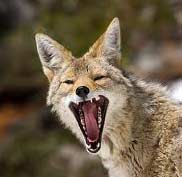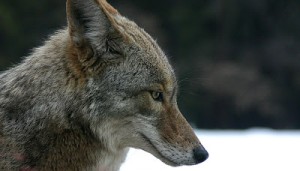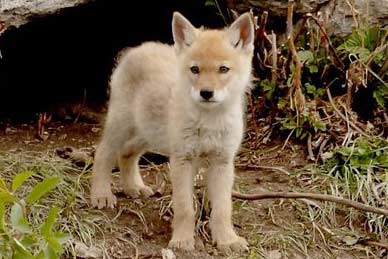 It’s about 8 o’clock on Monday evening—the first night of program—and my cabin group and I are sitting outside for Nocturnal Nations class. The forest is thick and dark around us, only thinning out above where the stars make silhouettes of the pine trees. We’re bundled up in jackets, hats, and gloves, but I can still see a ring of foggy breath rise from our circle as my boys repeat vocab words back to me: “diurnal,” “nocturnal,” “crepuscular.”
It’s about 8 o’clock on Monday evening—the first night of program—and my cabin group and I are sitting outside for Nocturnal Nations class. The forest is thick and dark around us, only thinning out above where the stars make silhouettes of the pine trees. We’re bundled up in jackets, hats, and gloves, but I can still see a ring of foggy breath rise from our circle as my boys repeat vocab words back to me: “diurnal,” “nocturnal,” “crepuscular.”
Then, out of the forest, comes a sudden, shrill scream—high-pitched and with an edge of sorrow to it—that lingers for several seconds until it slowly fades and then disappears.
We all fall silent at once. Anyone who wasn’t paying attention before is now sitting erect and wide-eyed. “What was that?” the students anxiously ask me. “Ssshhhh,” I beckon, as the woeful wail picks up again, joined by another, and then another, until the crying nearly surrounds us in an invisible cacophony, off-tune and eerie, but majestic and intriguing. “Coyotes,” I answer.
 This isn’t an uncommon scene—we are often graced by the cries of coyotes, both night and day. Sometimes we’re lucky enough to see one, stealthily slipping through the forest or loping alongside the road. I always welcome these encounters as “teachable moments” because for me they represent the essence of outdoor science school—learning about nature through first-hand experiences.
This isn’t an uncommon scene—we are often graced by the cries of coyotes, both night and day. Sometimes we’re lucky enough to see one, stealthily slipping through the forest or loping alongside the road. I always welcome these encounters as “teachable moments” because for me they represent the essence of outdoor science school—learning about nature through first-hand experiences.
We can talk all day about predator/prey relationships, food webs, and adaptations, but there’s nothing like learning from a direct experience. “Why do you think we usually hear coyotes at night? Why do you think they cry like that? Do coyotes have any adaptations to help them survive here?” Moments like these provide students with an experiential knowledge not readily found back home in the city, which is especially valuable when dealing with an animal as misunderstood as the coyote.
 Coyotes are traditionally labeled as troublemakers. In folklore they often play the role of the mischievous trickster, cunning and immoral. They’re known to steal livestock and harass domestic pets. In recent years they’ve become increasingly infamous due to their growing prevalence in urban and suburban settings. But coyotes are prime examples of being adaptable and versatile—part of our lessons to students—and should be respected for it.
Coyotes are traditionally labeled as troublemakers. In folklore they often play the role of the mischievous trickster, cunning and immoral. They’re known to steal livestock and harass domestic pets. In recent years they’ve become increasingly infamous due to their growing prevalence in urban and suburban settings. But coyotes are prime examples of being adaptable and versatile—part of our lessons to students—and should be respected for it.
Humans make many efforts to control coyote populations, but coyotes continually prove their resiliency. Studies have shown that when coyote control efforts increase, so do litter sizes, thereby enlarging populations. Coyotes are some of the few animals that thrive alongside human civilization, taking advantage of accessible resources—food, water, and shelter, the same things we require. They shouldn’t be blamed for doing their best to survive, as any human would do the same.
Despite persecution, coyotes play an important role in their habitat. They figure prominently in food webs and fulfill a crucial niche, helping to control populations of other species like rabbits and mice. In urban environments, coyotes have been known to limit rising Canada goose populations by eating their eggs.
 We strive to teach students about the balance of ecosystems and coyotes are a wonderful teaching tool for such subjects. They not only exemplify scientific concepts, but also play on the imagination, lending an air of mystery to the natural world—something that can’t be taught, only felt. Hearing a coyote’s call in the night or seeing one slip into the shadows is an experience that will resonate with students long after leaving the mountains, and hopefully spark an interest for an amazing creature often disdained as a nuisance.
We strive to teach students about the balance of ecosystems and coyotes are a wonderful teaching tool for such subjects. They not only exemplify scientific concepts, but also play on the imagination, lending an air of mystery to the natural world—something that can’t be taught, only felt. Hearing a coyote’s call in the night or seeing one slip into the shadows is an experience that will resonate with students long after leaving the mountains, and hopefully spark an interest for an amazing creature often disdained as a nuisance.

At High Trails Outdoor Science School, we literally force our instructors to write about elementary outdoor education, teaching outside, learning outside, our dirty classroom (the forest…gosh), environmental science, outdoor science, and all other tree hugging student and kid loving things that keep us engaged, passionate, driven, loving our job, digging our life, and spreading the word to anyone whose attention we can hold for long enough to actually make it through reading this entire sentence. Whew…. www.dirtyclassroom.com

Comments are closed.